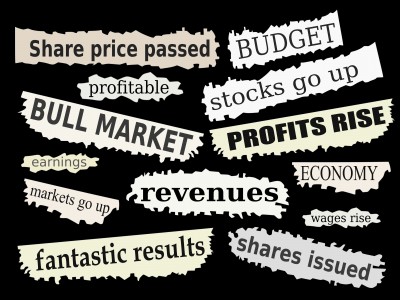Everything I’ve ever known to be right has been proven wrong.
I’m drifting along.— Dylan, “Hattie Moore”
Element # 1 to John Bogle’s Big Mistake — Buying the Market
Indexing is buying the market. The benefit is that, if the market does well, the index does well. The risk is, if the market does poorly, the index does poorly. The indexer ties his fate to the fate of the market as a whole.

John Bogle recommends indexing. He urges the middle-class investor to tie his fate to the fate of the market. That’s the essence of his investing approach.
Element # 2 to John Bogle’s Big Mistake — Being Satisfied with Not Beating the Market
Is it a good idea for the middle-class investor to tie his fate to the fate of the market?
John Bogle makes a compelling argument that it is. The case is built on the evidence of the historical stock-return data. U.S. stocks have for a long, long time been providing a long-term annualized return of about 6.5 percent real. With that sort of return available to those who buy the market, is there really any need to take on the effort and risk associated with trying to beat the market?
Bogle makes a good case that obtaining market returns is in many cases good enough. I see no reason why those who possess the skill and energy and time needed to beat the market should not aim to do so. For most of us, though, I am persuaded that market returns are good enough. Indexing provides a means for the average investor to do exceedingly well without devoting much time to learning sophisticated strategies.
John Bogle’s breakthrough insight — that a long-term real return of 6.5 percent is available to those willing to follow the simple step of buying the market — represented a revolutionary advance in our understanding of what it takes to succeed at investing. It’s hard to beat the market. It’s easy to match it. And matching it promises highly appealing long-term returns.
Element # 3 to John Bogle’s Big Mistake — When the “Long-Term” Kicks in Makes All the Difference.
Step Three is a doozy. This is where John Bogle’s investing approach goes from being something that is a boon to the middle-class investor to being something that may well be the middle-class investor’s downfall.

The long-term return on U.S. stocks is 6.5 percent real. How long do you have to be willing to wait to be realistically assured of obtaining a 6.5 percent return? How far out is the “long-term”? It depends.
On what?
On the valuation level that applies at the time you make the stock purchase.
Buy stocks at reasonable prices, and you can be reasonably assured of obtaining a 6.5 percent real return within 10 years. Buy stocks at sky-high prices (like those that apply today — this article was posted in February 2007) and you might have to wait for 30 years or more to get a return anywhere even remotely in the neighborhood of 6.5 percent.
Most middle-class investors can wait 10 years. Most middle-class investors cannot wait 30 years or more. We cannot afford to be investing a large portion of our live savings for a promise that will remain unfulfilled for three decades. Many of us will need to sell if we do not obtain our expected return for 30 years or more. The John Bogle investing approach does not work at times of high valuations.
John Bogle’s breakthrough insight — that buying the market provides good enough returns — is a half-truth. Define “long-term” as meaning a time-period of 30 years or longer, and it is rooted in an historical reality. In practical terms, however, the Bogle claim is as much false as it is true. Most indexers of today are not prepared to wait 30 years to obtain the appealing returns promised by advocates of this investing approach.
Element # 4 to John Bogle’s Big Mistake — A Hope That It Will Be Different This Time Offers Little Comfort
John Bogle is aware of the effect that valuations have on long-term returns. Here are some words from a John Bogle speech on reversion to the mean: “Reversion to the mean is the rule, not only for stock sectors, for individual equity funds, and for investment strategies that mix asset classes, it is also the rule for the returns provided by the stock market itself.” That’s a big problem for indexers.

If stocks provided 6.5 percent real each and every year, the conventional approach to indexing would be a sound investing approach. Stocks do not provide 6.5 percent real each and every year. There are times when stocks provide returns far greater than that. Following those times come times when stocks provide returns far less than that, pulling the long-term return back down to 6.5 percent real. It’s because we have time-periods in which stocks are providing returns of far less than 6.5 percent real that Bogle’s investing approach (conventional indexing) does not work.
Bogle’s blunder comes in the words following those quoted above. Bogle’s response to the reality of reversion of the mean (and the lower returns at times of high prices that go with it) is to offer up a wish, a hope and a prayer that it might turn out different this time. He says: “Since the market’s 15% return in the decade ended in 1998 was the third highest in all history, one can only hope that the full might of RTM [Reversion to the Mean] does not strike again.”
Tilt!
The appeal of indexing is that it is a rational approach to investing, an approach rooted in what we learn about how to invest from studying the historical stock-return data. Bogle is with these words leaving the world of reason and logic and entering the world of emotion. Sure, we can “hope that the full might of RTM does not strike again.” Can we count on it though? Dare we assume it when putting together our investment plans? Is it reasonable for us to put our hopes for safe retirements at risk on these sorts of hopes?
We cannot count on it. We dare not assume it. It is not reasonable for us to put our hopes for safe retirements at risk on these sorts of hopes. In all likelihood, we are going to see Reversion to the Mean again. In all likelihood, returns are going to be far less than what most indexers are expecting. In all likelihood, John Bogle’s investing approach is going to be proven a failure in its first real-world test.
 The test of Bogle’s approach was not the wild bull market that came to an end in early 2000. The first real test began in that year and will continue for the length of the secular bear market. Indexing works only for those who practice buy-and-hold strategies. Only those prepared for what is to come can reasonably be expected to be able to hold through a secular bear. Indexers who are counting on unjustified hopes that it will be different this time are not properly prepared for the price jolts ahead of us.
The test of Bogle’s approach was not the wild bull market that came to an end in early 2000. The first real test began in that year and will continue for the length of the secular bear market. Indexing works only for those who practice buy-and-hold strategies. Only those prepared for what is to come can reasonably be expected to be able to hold through a secular bear. Indexers who are counting on unjustified hopes that it will be different this time are not properly prepared for the price jolts ahead of us.
Bogle’s breakthrough was in taking a rational approach to the art of investing. He did something very important when he did that, in my view. Bogle’s big mistake was in abandoning reasons and taking comfort in wishes, hopes and dreams when faced with the reality of what Reversion to the Mean translates into for the typical follower of his investing approach.
Bogle properly determined the return for time-periods of over 30 years to be 6.5 percent. He acknowledged that Reversion to the Mean requires 10-year and 20-year returns at times of high valuation to be a good bit less than that. Bogle’s big mistake was in failing to calculate how much less and to share with indexers how much less.
Element # 5 to John Bogle’s Big Mistake — Thinking Prices Would Never Climb This High
My guess is that Bogle possessed a foggy idea of the error he was committing at the time he committed it. He is familiar with the historical stock-return data. He understands the importance of the Reversion to the Mean concept. My guess as to why he did not explore the implications of Reversion to the Mean to the long-term success of his investing approach is that he did not anticipate stock prices ever going as high as they have gone today. Please understand that that is only a guess.
To appreciate the magnitude of John Bogle’s mistake, you need to read Robert Shiller’sIrrational Exuberance. Bogle has not put indexers at risk of suffering small losses. He has put them at risk of suffering huge losses. There have been three times in the history of the U.S. market when we have traveled to the la-la land prices that apply today. The average price drop experienced on those three occasions was 68 percent. In the event that stocks perform in the future anything at all as they always have in the past, millions of indexers (and millions of non-indexers influenced by the arguments made on behalf of indexing) stand to lose large portions of their life savings as a result of John Bogle’s big mistake.

Element # 6 to John Bogle’s Big Mistake — The Error is Encapsulated in the Phrase “Stay the Course!”
“Stay the Course!”
It’s John Bogle’s favorite bit of investing advice. It’s the key strategy followed by conventional indexers.
It is poor advice.
Please think back on what we have determined by working through the first five steps of Bogle’s big mistake. Indexing makes sense. Bogle’s discovery of a way to obtain good-enough returns with little need to spend lots of time on investing or to take on unappealing levels of risk was revolutionary stuff. But there is a big practical problem with indexing — remain heavily in stocks at times of high valuations and sooner or later you will get killed.
The obvious moral is — Whatever you do, do not stay the course. Yes, buy the market return when buying stocks. But, no, don’t even think of going with the same stock allocation at all times.
If you stay the course with a high stock allocation, you are almost sure to someday be wiped out. No one knows precisely when that next 68 percent price drop is coming. However, if you believe that the historical data provides useful guidance on how to invest for the long-term (the indexing concept is rooted in this belief), then you know that it is coming. So you must step aside. You must lower your stock allocation at times when the risk is greatest.
Would it be possible to stay the course with a low stock allocation? It would be possible, but it would not be financially rewarding. It is unlikely whether most middle-class investors can bear overall portfolio losses of more than 20 percent without suffering the feelings of panic that cause buy-and-hold strategies to fail. So stock allocations of much greater than 30 percent are dangerous at times of high valuations (when the possibility of a price drop of something in the neighborhood of 68 percent becomes too real to ignore). Staying the course with a stock allocation

of 30 percent might work in the long run. But keeping your stock allocation at so low a level is giving up an awful lot of money at times of moderate and low valuations.
John Bogle’s “Stay the Course!” advice just flat-out does not make sense. Bogle’s admonition to “Stay the Course” is dangerous advice.
Element # 7 in John Bogle’s Big Mistake — “Stay the Course!” is Generally Interpreted to Mean Something Other Than What Bogle Intends for It to Mean
Everyone makes mistakes. The Bogle mistake should never have become such a big deal. In the ordinary course of events, this mistake would have been corrected, and that would have been the end of it.
The Bogle mistake has not been corrected. The primary reason, I believe, is that “Stay the Course!” sounds like very sensible advice indeed. To those who do not think it through carefully, it sounds as if Bogle is advising us to stick with our investing strategies long enough to see them pay off.
The reality is that Bogle is arguing for precisely the opposite course of action. When Bogle says “Stay the Course!” he is not telling us to stick with our investing plans. He is telling us to permit them to be altered in dramatic ways.
Huh?
Say that you are trying to steer a boat through the ocean. You have checked a map and know that all you need to do to reach your destination is to continue sailing straight ahead. In short, you need to “Stay the Course!” You notice a change in the winds and in the currents. What is your response? Do you hold the wheel firm in the face of these changes or do your make gentle turns to the left or to the right to counter the effects of the changing conditions about you?
You make gentle turns, of course. An informed understanding of what it means to “Stay the Course!” is that it requires reasonable responses to changed conditions. When valuations change, the “Stay the Course” investor needs to change his stock allocation to keep his risk profile consistent with what he determined it should be back when he set his initial allocation.

Bogle does not advocate Valuation-Informed Indexing (at this time!). When he says “Stay the Course!” he means to stick with the same stock allocation, not to stick with the same risk profile. He is recommending that you be consistent with the thing that does not matter (your stock allocation percentage is just a number) while being inconsistent with the thing that determines the long-term success or failure of your investing plan (it is essential that you keep your risk profile stable).
The phrase “Stay the Course!” makes a great deal of sense. Bogle’s use of it (that it requires maintaining a fixed allocation percentage in the face of dramatic changes in the riskiness of stocks) makes zero sense. The result is that Bogle’s mistake has gone uncorrected for a good number of years now. People don’t see the error because the phrase “Stay the Course!” possesses a good bit of surface appeal. Only those who possess a deep understanding of the message of the historical stock-return data are able to appreciate the danger of Bogle’s mixed-up formulation of it.
Indexing works. The conventional approach to indexing does not work. The sensible way to index is to change your stock allocation in response to dramatic changes in the price at which stocks are being sold.
